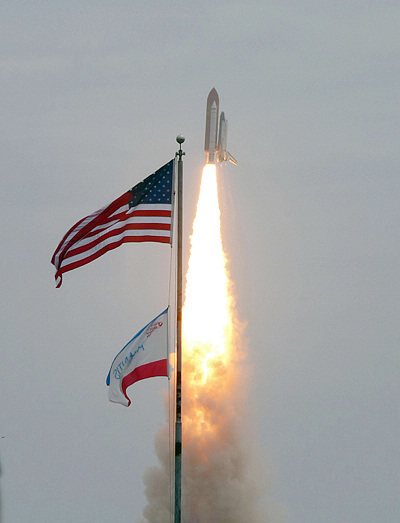|
 |
|
FINAL FLIGHT: Space shuttle Atlantis blasts off from the Kennedy Space Center in Florida on July 8 for its last mission (XINHUA) |
The space shuttle Atlantis blasted off for its last mission on July 8. Carrying four astronauts, the 26-year-old shuttle streaked into the sky from the Kennedy Space Center for the final time. The flight marked the end of the United States' space shuttle program.
End of an era
The United States began to develop space shuttles in 1972. Six space shuttles were eventually built: Enterprise, Columbia, Challenger, Discovery, Atlantis and Endeavour. Among those, Enterprise was a trial shuttle tested in 1977, and in 1981, Columbia became the first space shuttle to leave Earth's atmosphere.
The success of the space shuttle program is an important milestone in the development of space technology. As the world's first reusable manned spacecraft, the shuttle represents the height of human achievement in terms of space flight.
Of course, since the first space shuttle lifted off 30 years ago, a number of problems and flaws with the shuttle have also been exposed. Ultimately, economic efficiency and safety were the major reasons behind the U.S. Government's decision to abandon the shuttle program and focus its attention on a new manned space transportation system.
The main purpose of the U.S. space shuttle program was to reduce the cost of space flight through the use of a reusable vehicle and to increase the frequency of manned flights to space.
The space shuttle, however, did not succeed in realizing these initial goals. From 1981 to 2011, five space shuttles made 135 flights in all. On average, shuttles flew five times a year, far from the target of 25 launches per year. Moreover, the space shuttle program severely exceeded its original budget. Developing the shuttle alone cost nearly $2 billion (at 1970s rates) more than originally planned.
And while it was expected that each shuttle launch would cost $38 million, when the space shuttle finally entered service, the actual expenditure on each flight was $150 million (at 1980s rates). In recent years, expenditure on each launch has reached $400 million to $500 million.
The shuttle program also performed below expectations in terms of safety and reliability. On January 28, 1986, space shuttle Challenger exploded moments after its takeoff, killing all seven of its crew. Seventeen years after the Challenger tragedy, space shuttle Columbia crashed on its return voyage on February 1, 2003, and seven crew members lost their lives. As the shuttles continued to serve the U.S. space program into the 2000s, safety became an increasingly serious concern and the termination of the program became inevitable.
| 